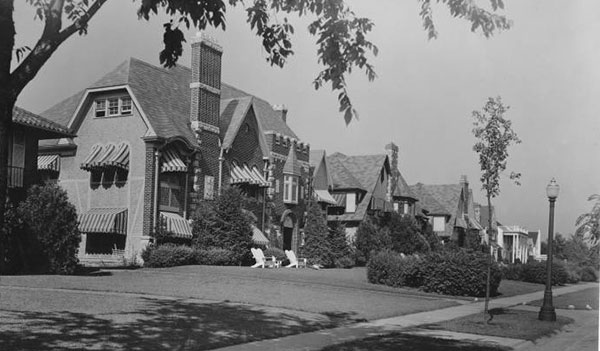
As time passes, people in Armour Hills and Mission Hills forget what links them to so many other neighborhoods.
“After 110 years of existence, the identity of the Country Club District is starting to fade,” said LaDene Morton.
She spoke at the Kansas City library at the Plaza last week about her new book, The Country Club District of Kansas City.
Morton, a former policy analyst at Midwest Research Institute, has also written history books about Brookside and Waldo.
From her presentation:
J.C. Nichols’ vision and district gained national attention by the 1920s as one of the nation’s great experiments in city planning.
He started it in 1905, worked until he died in 1950, and development continued for decades under the company he founded.
The Brookside neighborhood was born in 1919, Crestwood in 1922, the Plaza in 1923, and so on. By Nichols’s death, the district covered about 6,000 acres.
When it started, the area was considered far south of the city. Nichols saw a vast future market for “garden homes” in a rural setting.
This was 1905, before zoning laws. Horse droppings and flies marked city streets, and smelly factories spewed all manner of filth.
The economy was strong, the middle class was growing, and people who had never owned homes wanted them.
Call Nichols a salesperson, a persuasive visionary, or both: he wanted people to live in stable communities with schools, churches, parks, recreation, and more – places they would stay.
Before his death, he largely accomplished all that in the area covered by the book: On the north from 47th Street near Brush Creek south to near Gregory Boulevard, from about Oak Street on the east in Missouri to Mission Road in Kansas.
When he started developing the area, the only way to get groceries was a long trip to Westport, so Nichols built shops.
Over the years, he got schools, churches, and recreation facilities in the area. He noted the proximity to the Kansas City Country Club, where Loose Park is now.
He developed houses for both the middle class and the rich. He used golf courses—some of them short-lived—to hold land and buffers in front of land he did not control.
For communication, he put out a newsletter, The Country Club District Bulletin.
Area news and names of new homeowners were in it, and much more.
He couldn’t get enough of “little neighborhood stuff,” Morton said, and “he was also a master of promotion.”
Every new shopping center ran big on the front page. And he could be something of a scold.
He told people not to litter, dump ashes in gutters, or leave garage doors open.
He was big on social event coverage, Morton said. “There was bird watching, there was bicycling, there was gardening,…you name it.”
Morton showed a 1925 picture from the sky of the area around where the Plaza Library is now, with much empty land surrounding it. Then she showed one from 1930 with houses and buildings all over that land.
With the Depression, new housing construction slowed, and more commercial buildings were built until housing picked up after World War II.
Morton said the district is the nation’s most extensive single-family residential development.
Roland in Baltimore, another “garden suburban community,” came before it. Beverly Hills became more famous, but none of the others were on such a giant scale.